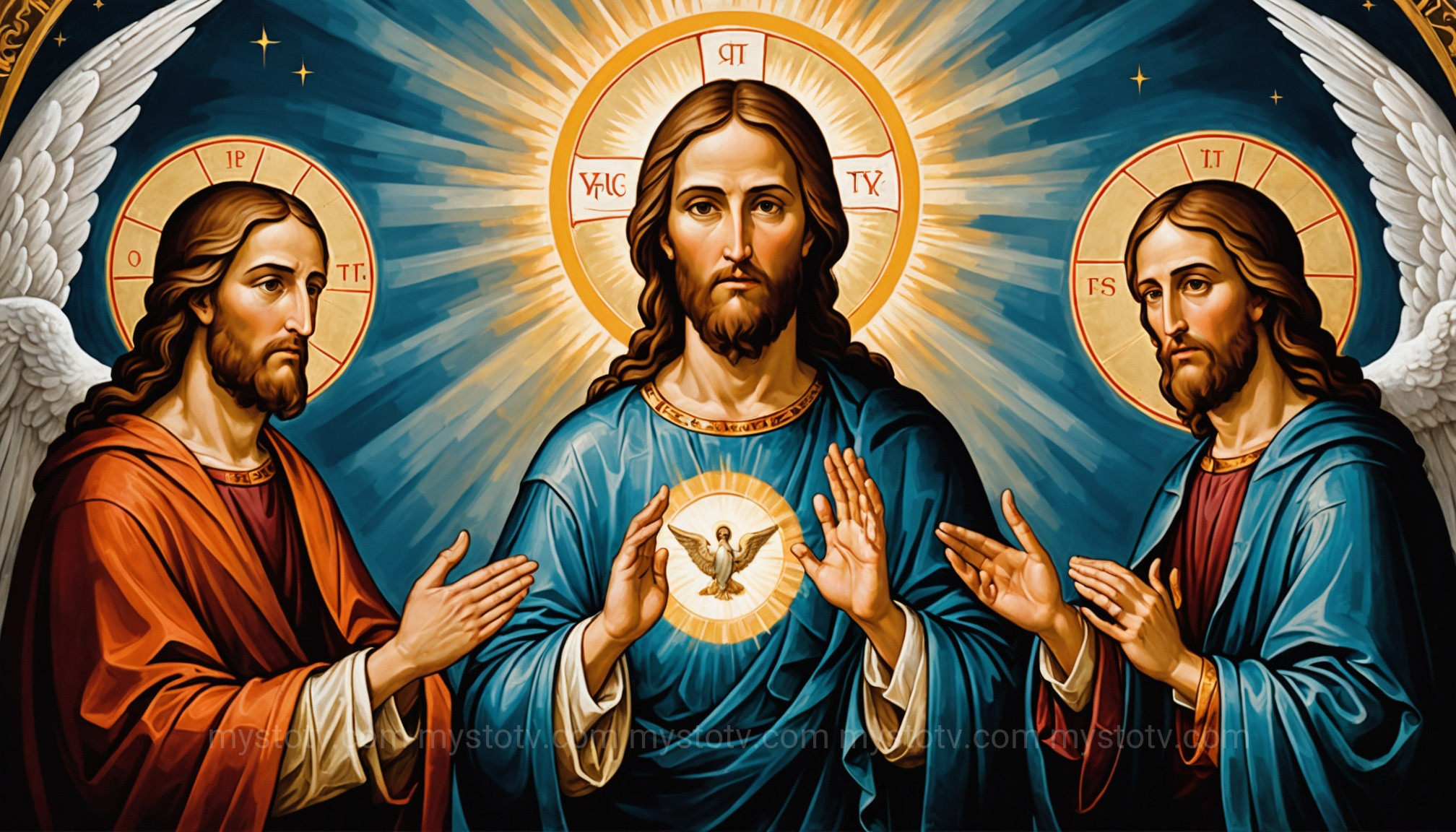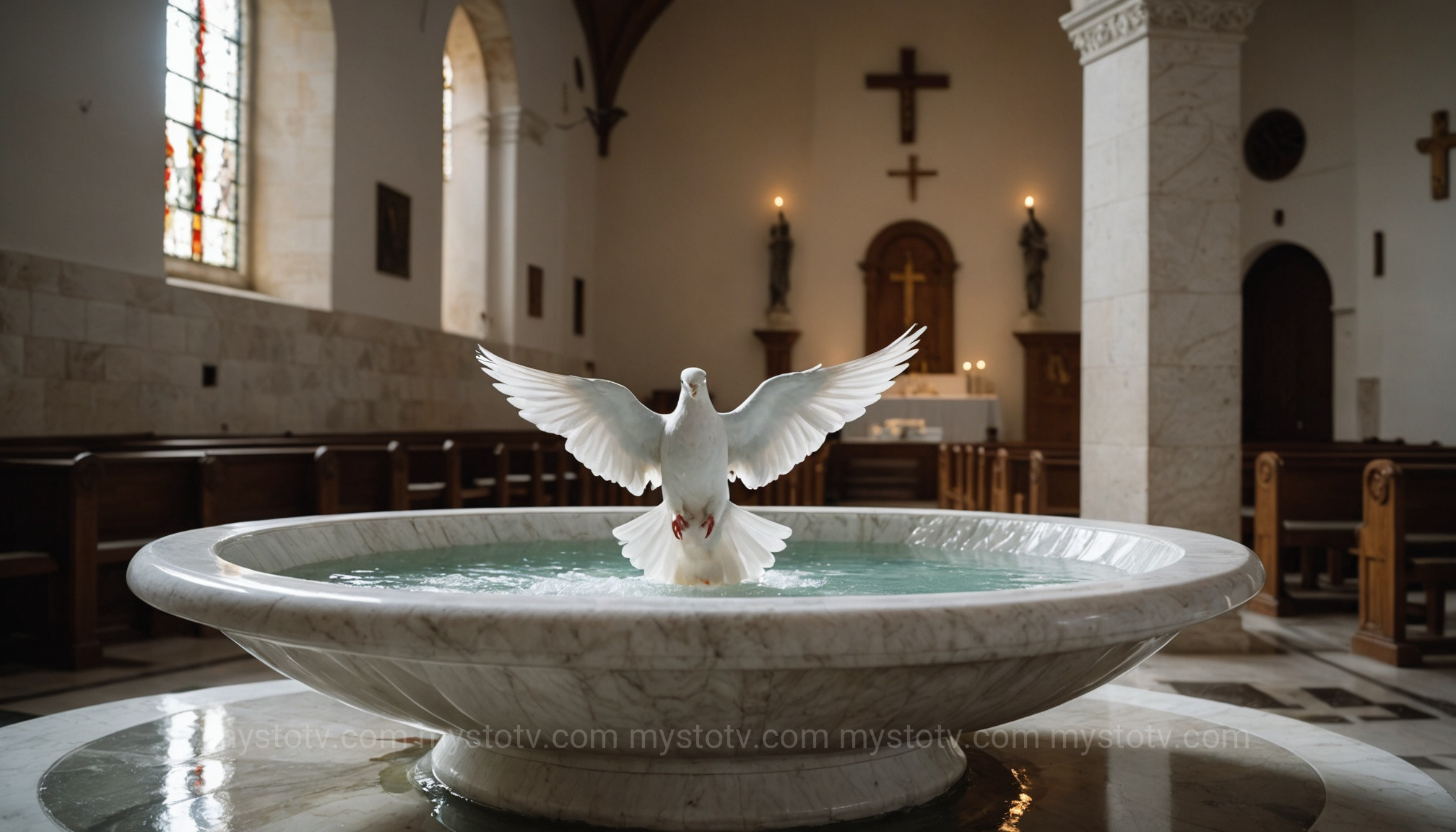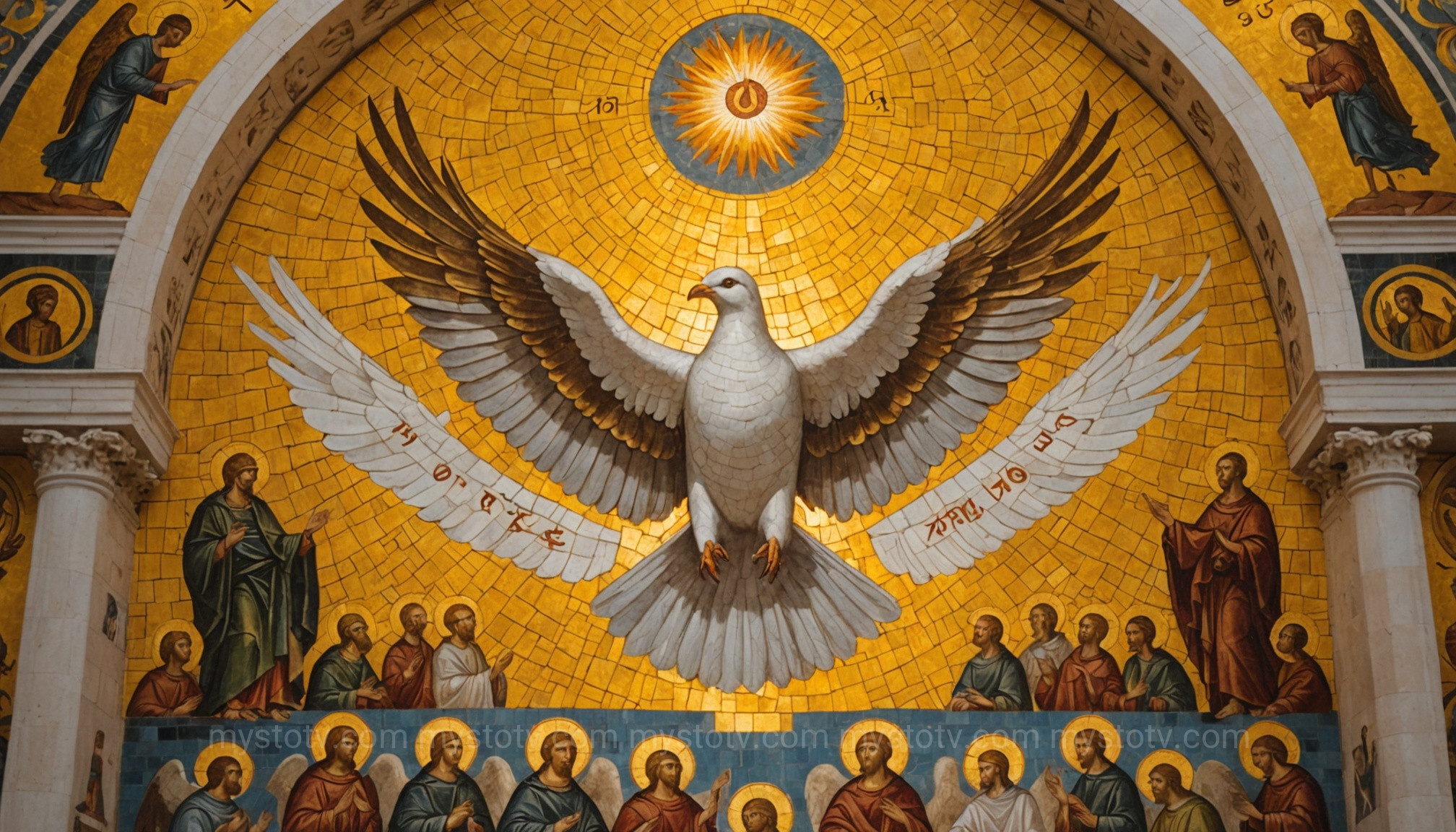I remember my Confirmation day vividly. Not for a bolt of lightning or a booming voice from the heavens, but for a quiet, profound sense of clarity that settled over me as the bishop anointed my forehead with chrism oil. For years, the Holy Spirit had been an abstract concept, the most mysterious member of the Trinity. But in that moment, the theology became personal. It was the beginning of a lifelong journey to understand the real, active presence of the holy spirit roman catholic teaching speaks of—not as a distant force, but as a constant companion and guide. This article aims to unpack that journey, exploring the essential role and rich symbolism of the Holy Spirit, moving from abstract doctrine to the tangible ways He works in the Church and in our daily lives, making the concept of the holy spirit roman catholic faith more accessible.
Contents
- 1 The Divine Personhood of the Holy Spirit Roman Catholic Doctrine
- 2 The Essential Role of the Holy Spirit Roman Catholic Sacramental Life
- 3 The Gifts and Fruits: Living with the Holy Spirit Roman Catholic Teaching
- 4 Major Symbols of the Holy Spirit Roman Catholic Tradition
- 5 Frequently Asked Questions about the Holy Spirit Roman Catholic Perspective
- 6 References
The Divine Personhood of the Holy Spirit Roman Catholic Doctrine

In the heart of Catholic theology lies a crucial, often misunderstood truth: the Holy Spirit is not an 'it' but a 'He'. The Holy Spirit is not a mere divine energy, a cosmic force, or a metaphor for God's power. According to Roman Catholic doctrine, the Holy Spirit is the Third Divine Person of the Blessed Trinity, co-equal, co-eternal, and consubstantial with the Father and the Son. This means He possesses the same divine nature, yet is a distinct Person with a unique role in the economy of salvation. This understanding is foundational; without it, the sacraments lose their power and prayer to the Spirit loses its meaning. The Church's entire life—its liturgy, its mission, its saints—is animated by this Divine Person who was promised by Christ to be our Advocate, our Comforter, and our guide into all truth.
Scriptural Foundations for the Holy Spirit Roman Catholic Belief
The Catholic understanding of the Holy Spirit is not an invention of later theologians but is deeply rooted in Sacred Scripture. In the Old Testament, the Spirit of God, the Ruach Elohim, is present from the very beginning, depicted as the "mighty wind" sweeping over the waters of creation (Genesis 1:2). He is the breath of life God breathes into Adam and the power that anoints kings and inspires prophets. While the revelation of the Spirit's personhood is gradual, these early accounts lay the groundwork for what is to come.
The New Testament brings this revelation to its fullness. At Jesus' baptism in the Jordan, the Spirit descends in the form of a dove. Most significantly, in John's Gospel, Jesus makes a profound promise to his disciples before his Passion: "I will ask the Father, and he will give you another Advocate to be with you always, the Spirit of truth" (John 14:16-17). This "Advocate," or Paraclete, is clearly presented as a distinct person who will teach, remind, and testify. This promise is fulfilled dramatically at Pentecost (Acts 2), when the Holy Spirit descends upon the Apostles as tongues of fire, empowering them to begin the Church's universal mission. This event is often called the "birthday of the Church," as it marks the moment the holy spirit roman catholic tradition sees as the public inauguration of the Church's life.
The Holy Spirit's Relationship with the Father and the Son
A key aspect of the holy spirit roman catholic theology is the procession of the Spirit. The Nicene-Constantinopolitan Creed, recited at Mass, states that the Holy Spirit "proceeds from the Father and the Son" (in Latin, Filioque). This phrase, "and the Son," has been a point of historical and theological divergence with the Eastern Orthodox Churches, but for Catholics, it holds a vital theological meaning. It emphasizes the intimate, eternal relationship within the Trinity. The Spirit is the eternal bond of love between the Father and the Son. He is not a subordinate or a later creation but exists in this eternal, loving exchange.
Analysis: Understanding the Spirit's personhood and His procession from the Father and the Son is not merely an academic exercise. It transforms our spiritual lives. It means we are not trying to connect with an impersonal force, but rather entering into a personal relationship with a Divine Person who loves us. He is the one who draws us into the very life of the Trinity, making it possible for us to call God "Father" and to know Jesus Christ personally. The Spirit is the active agent of our adoption as sons and daughters of God.
The Essential Role of the Holy Spirit Roman Catholic Sacramental Life
If the Holy Spirit is the soul of the Church, then the sacraments are its arteries. It is primarily through the seven sacraments that the holy spirit roman catholic faith believes this divine life is communicated to the faithful. The Holy Spirit is not just present during the sacraments; He is the principal agent who makes them effective channels of God's grace. Each sacrament is an encounter with Christ, made possible by the action of the Holy Spirit.
The Spirit in Baptism and Confirmation

In Baptism, the Holy Spirit's work is one of radical transformation. It is through His power that we are cleansed from original sin, reborn as children of God, and incorporated into the Mystical Body of Christ, the Church. The priest or deacon prays for the Spirit to come upon the water, sanctifying it for this sacred purpose. This action echoes the Spirit hovering over the waters of creation; here, He brings about a new creation in the soul of the baptized.
Confirmation completes the grace of Baptism and is often called the "sacrament of the Holy Spirit." Here, the bishop (or a delegated priest) anoints the candidate with sacred chrism oil and says, "Be sealed with the Gift of the Holy Spirit." This is not a symbolic gesture but a true impartation of the Spirit, strengthening the individual for the mission of Christian witness. It equips the confirmed with the Seven Gifts of the Holy Spirit, empowering them to live a mature Christian life and to defend and spread the faith. This sealing marks the soul with an indelible spiritual character, signifying that the person belongs to Christ and is enlisted in his service.
The Holy Spirit in the Eucharist and other Sacraments
Perhaps the most profound and explicit invocation of the Holy Spirit occurs during the Mass in a prayer known as the epiclesis. Just before the consecration, the priest extends his hands over the bread and wine and prays that the Father send the Holy Spirit upon them, so that they may become the Body and Blood of Christ. It is a moment of immense power and mystery. The Church teaches that it is the power of the Holy Spirit that effects this change, known as transubstantiation.
This divine action extends to all other sacraments. In the Sacrament of Penance (Reconciliation), it is the Holy Spirit who convicts us of sin and gives the grace of conversion, and it is through the priest, acting in the person of Christ, that the Spirit's forgiveness is imparted. In the Anointing of the Sick, the Spirit brings healing, peace, and courage. In Holy Orders, the Spirit consecrates a man for priestly service, and in Matrimony, the Spirit seals the covenant between husband and wife, making their union a sign of Christ's love for the Church. The entire sacramental economy is a testament to the active, life-giving work of the holy spirit roman catholic tradition.
The Gifts and Fruits: Living with the Holy Spirit Roman Catholic Teaching
The relationship with the holy spirit roman catholic faith envisions is not a one-time event but a continuous, dynamic reality. The Spirit's presence is meant to transform our entire being, shaping our thoughts, words, and actions. This transformation is made visible through the Gifts and the Fruits of the Holy Spirit.
The Seven Gifts of the Holy Spirit
Traditionally based on a passage from Isaiah 11:2-3, the Church identifies seven gifts that the Holy Spirit bestows upon the faithful, particularly strengthened in Confirmation. These are not talents or skills in the worldly sense but supernatural dispositions that make us docile to the promptings of the Spirit. They perfect the human virtues and allow us to respond to God's will.
- Wisdom: The ability to see things from God's perspective, to value what He values.
- Understanding: The grace to grasp the deeper meaning of the truths of the faith.
- Counsel (Right Judgment): The capacity to discern right from wrong and to choose the correct path in concrete situations.
- Fortitude (Courage): The strength to overcome fear and to remain steadfast in the face of trial and temptation.
- Knowledge: The ability to see the created world as God's creation and to understand its proper place in our lives.
- Piety (Reverence): A deep sense of reverence for God and a desire to worship Him and serve others out of love for Him.
- Fear of the Lord (Wonder and Awe): Not a servile fear, but a profound respect for the majesty of God and a healthy fear of offending Him through sin.
Analysis: These gifts are the "sails" of our spiritual life. While we must still "row" with our own effort (through prayer, good works, and virtue), the Gifts of the Spirit allow us to catch the "wind" of God's grace, propelling us toward holiness far more effectively than we could on our own. They are the tools given to us to build a life of sanctity.
The Twelve Fruits of the Holy Spirit
If the Gifts are the tools, the Fruits are the results. St. Paul, in his letter to the Galatians (5:22-23), lists the perceptible qualities that arise from a life lived in the Spirit. The Catholic tradition lists twelve:
- Charity (Love)
- Joy
- Peace
- Patience
- Kindness
- Goodness
- Generosity
- Gentleness
- Faithfulness
- Modesty
- Self-control
- Chastity
Analysis: The Fruits are the litmus test of our spiritual health. They are the observable evidence that the Holy Spirit is at work within us and that we are cooperating with His grace. You cannot "try" to be joyful in a Christian sense; joy is a fruit that grows naturally from a life rooted in God's love (charity). Likewise, true peace and patience are not merely the results of strong willpower, but the effect of the Spirit's calming and ordering presence in our souls. Understanding the connection between these results and their divine origin is key to a mature faith.
Major Symbols of the Holy Spirit Roman Catholic Tradition

Because the Holy Spirit is pure spirit, He cannot be seen with our eyes. To help us understand His actions and nature, God has provided tangible symbols throughout salvation history. These symbols are not arbitrary; they are rich with meaning and reveal different aspects of the work of the holy spirit roman catholic tradition.
Water and the Holy Spirit
The symbolism of water signifies the Holy Spirit's action in Baptism. Just as water cleanses the body and sustains physical life, the Spirit cleanses the soul from sin and bestows the new life of grace. "Unless one is born of water and the Spirit, he cannot enter the kingdom of God" (John 3:5). This connection recalls the first creation, where the Spirit moved over the waters.
Anointing with Oil and the Holy Spirit
Anointing with oil is synonymous with the Holy Spirit. In fact, the very name "Christ" means "Anointed One." In the sacraments of Confirmation, Anointing of the Sick, and Holy Orders, the anointing with sacred chrism or the oil of the sick signifies consecration, healing, and strengthening by the Holy Spirit. It's a sign of being set apart for God's service and imbued with His power.
Fire and the Holy Spirit
Fire symbolizes the transforming energy of the Holy Spirit's actions. At Pentecost, the Spirit descended as "tongues as of fire" (Acts 2:3). Fire purifies, illuminates, and gives warmth and zeal. The Spirit purifies our hearts, enlightens our minds with truth, and inflames our souls with the fire of God's love, empowering us for witness and mission.
Dove and the Holy Spirit
This is perhaps the most common and beloved symbol. At Jesus' baptism, the Spirit descended upon him in the form of a dove (Matthew 3:16). The dove represents purity, gentleness, and peace. After the flood, a dove brought Noah an olive branch, a sign of reconciliation between God and humanity. The Spirit as a dove signifies His gentle presence, bringing peace and reconciliation to the baptized soul.
Wind and Cloud
Wind (in Greek, *pneuma*, which can also mean "spirit" or "breath") signifies the powerful, invisible nature of the Holy Spirit. Jesus tells Nicodemus, "The wind blows where it wills... but you do not know where it comes from or where it goes; so it is with everyone who is born of the Spirit" (John 3:8). The mighty wind at Pentecost expresses His irresistible power. The cloud is a classic symbol of the divine presence, often seen in the Old Testament, which both reveals and veils God's glory—just as the Spirit does for us today.
Frequently Asked Questions about the Holy Spirit Roman Catholic Perspective
1. How can I pray to the Holy Spirit?
You can pray to the Holy Spirit directly, just as you would to the Father or the Son. A simple, powerful prayer is the traditional "Come, Holy Spirit, fill the hearts of your faithful and kindle in them the fire of your love." You can also speak to Him in your own words, asking for one of the seven gifts (like counsel when facing a big decision), for help in overcoming a specific fault, or simply for a greater awareness of His presence throughout your day.
2. What is the difference between the Gifts and the Fruits of the Holy Spirit?
Think of it this way: the Gifts are the "tools" and the Fruits are the "finished product." The Gifts (Wisdom, Fortitude, etc.) are supernatural abilities the Spirit gives you to live a holy life. When you use these gifts and cooperate with the Spirit's grace, the natural result—or "fruit"—is a change in your character. You become more loving, joyful, peaceful, patient, and so on. The Gifts are the cause; the Fruits are the effect.
3. Is the Charismatic Renewal part of the Roman Catholic Church?
Yes. The Catholic Charismatic Renewal is a movement within the Church that received the approval and encouragement of popes from St. Paul VI to Francis. It emphasizes a personal and profound experience of the Holy Spirit and the exercise of charismatic gifts (like prophecy, healing, or speaking in tongues) for the building up of the Church. While its style of worship may differ from a traditional parish, it is a legitimate expression of faith within the holy spirit roman catholic tradition, focused on a personal Pentecost.
References
- Catechism of the Catholic Church. 2nd ed., Libreria Editrice Vaticana, 2012. (Specifically Part 1, Section 2, Chapter 3, Article 8: "I Believe in the Holy Spirit"). https://www.vatican.va/archive/ENG0015/_INDEX.HTM
- John Paul II. Encyclical Letter Dominum et Vivificantem (On the Holy Spirit in the Life of the Church and the World). 18 May 1986. https://www.vatican.va/content/john-paul-ii/en/encyclicals/documents/hf_jp-ii_enc_18051986_dominum-et-vivificantem.html
- The Holy Bible, Revised Standard Version Catholic Edition.
The holy spirit roman catholic understanding reveals not an obscure doctrine but a vibrant, personal reality. He is the Divine Person who animates the Church, gives life to the sacraments, and dwells within our souls as in a temple. He is the Advocate who defends us, the Comforter who consoles us, and the Spirit of Truth who guides us. By understanding His role and symbolism, we can move beyond abstract knowledge to a lived relationship, becoming more attentive to His gentle promptings and allowing His gifts to bear fruit in our lives. The journey that began for me at Confirmation is one open to every believer: a lifelong adventure of discovering the transformative power and intimate friendship of the Holy Spirit.